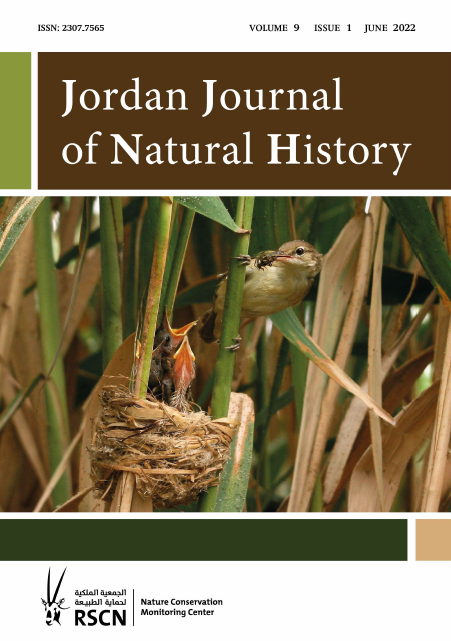Articles
Complementary Information on Leiurus jordanensis Lourenço, Modry and Amr, 2002, with a Description of an Adult Male (Scorpiones: Buthidae)
Author Name
Bassam Abu Afifeh, Mohammad Al-Saraireh, Zuhair S. Amr and Wilson R. Lourenco
The remarkable buthid scorpion Leiurus jordanensis Lourenço, Modry and Amr, 2002, discovered in the south of Jordan, was described on the basis of a single adult female probably. Limited information on adult males were presented in subsequent publications. The present note describes an adult male of L. jordanensis, collected from the type locality. Complementary information is also provided for this species.
Notes on Captive Breeding of Three Snake Species (Colubridae) from the Russian Far East
Author Name
Nikita E. Pokhilyuk
Rhabdophis tigrinus, Elaphe schrenckii, and Elaphe dione are three common snake species in northeast Asia. The present work focuses on the reproductive biology of the snake populations inhabiting Primorye (the southern Russian Far East). Over the period from 2019 to 2021, the researcher incubated five clutches of snake eggs which were either found in the wild or obtained from wild-caught individuals. Herein, the results are presented concerning the clutches’ size, duration of incubation, and thermal conditions for each species. During the study, the researcher observed a correlation between the snakes’ body length and the clutch size in E. schrenckii and a correlation between thermal conditions and the duration of the incubation period in R. tigrinus. Higher thermal conditions resulted in reducing the length of the incubation period.
On the Flora of the Northeastern Desert of Jordan
Author Name
Yassen Ananbeh, Jamil Lahham, Ahmad El Oqlah, Nisreen Al-Quraan, Khaled Abulaila and Mustafa Shudiefat
A total of 194 species which belong to forty-four families were recorded from the northeastern desert of Jordan between 2010 and 2013. This is the first documentation of the flora of Jawa and Um Al Quttain areas and their vicinities. The most diverse families were Asteraceae (22.6%), Fabacae (9.7%), Lamiacaea (8.2%), and Cruciferae (6.7%), while fourteen families were represented by a single species. Most recorded plants were annual plants (45%). The flora of the study area is a mixture of Saharo-Arabian, IranoTuranian, and Mediterranean elements. The present study shows that Jawa and Um Al Quttain plant communities have a high species diversity.
Four New Records of Snake Species in Ar'ar Region, Northern Border of Saudi Arabia
Author Name
Ahmed Mohajja Alshammari
The current study represents the first comprehensive survey of snakes in the Arar region, northern Saudi Arabia. A total of twenty-seven specimens representing seven species that belong to four families (Viperidae, Colubridae, Psammophiidae, and Elapidae) are documented. The present study includes new records of snakes from the Arar region, namely Psammophis schokari, Walterinnesia aegyptia, Echis coloratus, and Lytorhynchus kennedyi.
A Possible Case of Hypopigmentation in the Southern Spotted Skunk (Spilogale angustifrons celeris Hall, 1938)
Author Name
José Manuel Mora and Inés Azofeifa
Several chromatic anomalies have been reported in Neotropical mammals including hypopigmentation. This abnormality is a genetic mutation affecting melanin biosynthesis, pigment granule trafficking, or membrane sorting which results in insufficiently pigmented indviduals. The southern spotted skunk (Spilogale angustifrons celeris Hall, 1938) inhabits the areas from the mountains of Nicaragua to central Costa Rica. An individual of this species, which was found dead in northwestern Costa Rica, exhibited brown reddish discolored parts on its coat instead of black, which appeared to be a case of hypopigmentation. This is the first case of a chromatic disorder reported in the southern spotted skunk within the whole natural distribution range of this species. There are only few cases of chromatic aberrations reported in the mammals of Costa Rica.
The Current Status and Population of the Threatened Bird Species in the Ahwar of Southern Iraq: Conservation and Management Approach
Author Name
Mudhafar A. Salim
The marshes of Southern Iraq, or ‘Ahwar’ are vast freshwater wetlands that extend over a fluctuated area of more than 2000 km2 in southern Iraq. These wetlands consist of four major components (Huwaiza, West Hammar, Central Marshes, and East Hammar) each of which has its own environmental features and significance. The Ahwar has been selected as a World Heritage property in 2016 for its outstanding universal, cultural, and natural values (OUV) . One of the key attributes of the exceptional environmental value of this site is its unique spot containing various freshwater wetland habitats in the middle of an extremely hot and dry region housing a considerable number of birds some of which are threatened on the global level. The current study sheds light on the current status of fourteen globally threatened bird species found in the Ahwar region (breeding or non-breeding species). it also describes the habitats and the current conservation status of these bird species which include nine waterbirds, and five water-related bird species in addition to those found frequently around and within the Ahwar region. The latter group of birds mainly uses the buffer zones along with some dry extensions within the natural components of the Ahwar. In addition, the current research presents, for the first time , a recent population estimation of the migrant and resident bird species in the Ahwar area for the sake of establishing a baseline for their monitoring programs in the future. This work uses the latest version of the IUCN Red List (Version 3.1) for the categorizing of the conservation status of the studied birds. Also, the study provides an assessment on the regional level (Regional RedList Assessment) of the current status of the fourteen bird species that live inside and around the Ahwar. By presenting these bird species, for the first time, as a key component of the biodiversity of this region , by highlighting the major threats to their survival, and by estimating their numbers, and determining their spatial distribution, this paper hopes to contribute to prioritizing the conservation efforts of the bird species in the unique freshwater ecosystem of the Ahwar
Agro-management Approaches for the Sustainability of the Biodiversity of Ancient Olive Orchards in Palestine
Author Name
Ahmad Alomary, Raed Alkowni, Samer Jarrar, Banan Alsheikh and Generosa Jenny Calabrese
Ancient Olive Orchards (AOOs) occupy most of the Palestinian lands and represent a vital cultural heritage. This study is aimed at assessing the impact of different farming systems on flora biodiversity. Fields with two different farming systems (organic-registered and traditional-managed) were subjected to soil fertility, biodiversity indices, and a socio-economic analysis between the years 2017-2018. The results showed a higher percentage (1.74%) of total organic matter in the organic-registered fields. Biodiversity indices (Shannon diversity index (H`) and Margalef’s index (D)) recorded higher values as well (3.27; 10.12, respectively), reflecting the impact of agricultural practices on wild diversity. The same was noted in ecological infrastructures where 330 different species in forty-eight families were identified. Even so, both farming systems were insignificantly different; and that might be attributed to the similarity of practices between them in Palestine. From a socioeconomic point of view, these practices are of a low cost and are economically wise while adding quality to the products. In Misilyah, AOOs were found to harbor plant biodiversity in synergic harmony. Thus, applying organic farming practices is recommended as the best socio-economic approach for biodiversity sustainability. Such practices are also potentially profitable through eco-tourism and are symbolic and representative of the national heritage of this area. Also, they can provide an additional source of income for the people of this area.
Rodents Diversity in Wadi As Sulai, Riyadh Province, Kingdom of Saudi Arabia
Author Name
Mounir R. Abi-Said and Mohammad S. Al-Zein
The rodents of Ar Riyadh Province, Kingdom of Saudi Arabia are not well documented. Twenty Sheman live traps were distributed in 23 sites along Wadi As Sulai in Ar Riyadh Province between February and April 2016 as a part of an ecological survey for the area. Nine species of rodents belonging to two families were caught four of which were reported for the first time at the species level in Ar Riyadh Province namely, Gerbillus dasyurus, Gerbilus cheesmani, Gerbilus nanus, and Meriones crassus. External, cranial, and dental measurements were recorded
Pin Tail Snipe (Gallinago stenura) : A Rare Winter visitor In Nilgiris, Tamil Nadu, India
Author Name
Nizamudheen Moinudheen and Arockianathan Samson
The pin-tailed snipe (Gallinago stenura) also known as the pintail snipe, is a small stocky wader. It breeds in northern Russia and migrates to spend the non-breeding season in southern Asia from Pakistan to Indonesia. It is the most common migrant snipe in southern India, Sri Lanka and much of Southeast Asia. It is a vagrant to northwestern and northern Australia, and to East Africa Kenya. These birds forage in mud or soft soil, probing or picking up food by sight. They mainly feeds on of molluscs, adult and larval insects, earthworms and occasionally crustaceans, seeds and other plant matter (del Hoyo et al. 1996). In this note we portray the first record of Pin Tail Snipe in Nilgiris, Tamil Nadu, Southern India.




